- The key components of FPV systems are floats, anchoring and mooring mechanisms, and solar modules, all essential for the system’s functionality and reliability
- Reliable anchoring is crucial for safety, with various methods like gravity anchors, piling anchors, and shore anchors being validated and used based on water bed conditions
- Cost optimization in FPV projects is shifting from focusing solely on CapEx to also emphasizing quality and OpEx.
With the FPV market quickly growing, so is the technology developing quickly as well. This chapter looks at developments of different components of floating solar systems.
The 3 key components of the FPV system are floats, anchoring and mooring, and solar modules. Floaters are the core of FPV, and several manufacturers offer a wide variety. Floaters need to be designed for very different system sizes. A typical floating system size today is between 500 kW and 10 MW. But there are increasingly larger system installations in the scale of several 100 MW, or even GW sizes. At the same time, as FPV is an emerging technology, a number of companies are still working on pilot projects of 5to 10 kW. Beyond floaters, reliable anchoring is the most important aspect of the FPV system as it plays a key role for safety and reliability. Sungrow, for example, offers different anchoring methods like gravity anchors, piling anchors and shore anchors. In collaboration with DNV, the Chinese market leader has validated its anchoring techniques and has drafted anchor design benchmarks for the Chinese market. The cheapest anchoring that can be installed is concrete deadweight, said Andrés Franco, CEO of Isigenere, as it can be built on the site and one can let it fall from the top. However, not every water body supports it. Different anchoring mechanisms have to be adapted according to the water bed. When it comes to modules, standard products have been mostly used that are suited for humid environments; but the leading manufacturers have been designing products that are tailored to the needs of FPV developers. However, an important trend, according to Franco, is that developers are opting for a low tilt of installed solar modules (see Global Expansion Of Floating Solar PV Systems).
As for inverters, Sungrow’s solutions for larger-scale electrical equipment, such as a booster integrated with a central inverter, can be mounted on floating boats, positioned adjacent to the power generation unit. When using string inverters, they are typically set within a dedicated cable channel inside the floating array and are securely attached to the float using metal brackets, according to Sungrow FPV Country Manager, Julia Wang. Isigenere’s Franco pointed out that central inverters are very heavy, weighing in tons, and require special floaters, and anchoring and mooring systems. As these extra costs do not compensate for energy losses or extra cabling costs with string inverters, more and more FPV projects are executed with string inverters and combiner boxes that are placed on floating islands, he added (see Top Players In Floating PV Industry).
Cabling is another important part in the system arrangement. With Sungrow’s solution, within the floating array, the cables are laid on the float, and cable floats are used to support cables coming out of the floating array to the shore. The cables are fixed by the cable brackets and the cable bridges are arranged to support water level variation. There is an increased emphasis on the integration of electrical components into the FPV structure, according to Franco.
Another important development within the FPV segment is about cost optimization. Unlike in the past, when CapEx used to be the center of the discussion, the market is realizing the importance of quality and OpEx, especially the ease of O&M, highlighted Franco. On this account, topics such as buoyancy and safety of O&M personnel are also gaining prominence in project discussions.
The text is an excerpt from the TaiyangNews Floating PV 2024 Report, which can be downloaded for free here.



